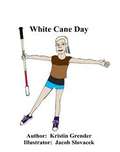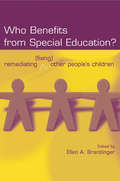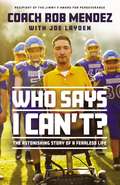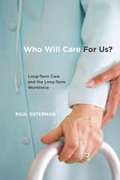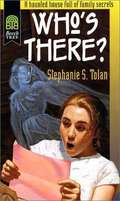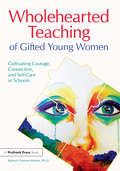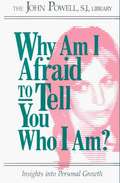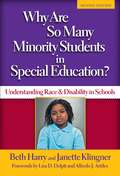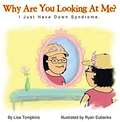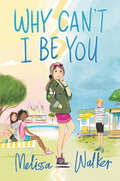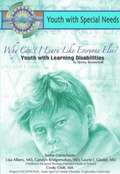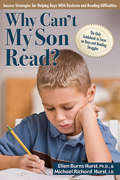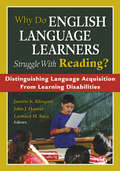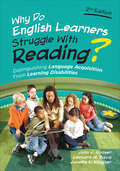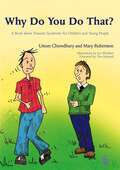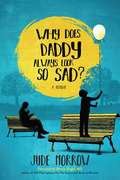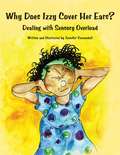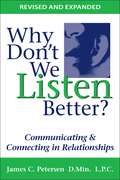- Table View
- List View
Where's Mummy Mouse?: Targeting the m Sound (Speech Bubbles 1)
by Melissa PalmerMolly mouse wakes to find her Mummy has vanished, so she sets off to find her – meeting some interesting creatures along the way. This picture book targets the /m/ sound, and is part of Speech Bubbles 1, a series of picture books that target specific speech sounds within the story. The series can be used for children receiving speech therapy, for children who have a speech sound delay/disorder, or simply as an activity for children’s speech sound development and/or phonological awareness. They are ideal for use by parents, teachers or caregivers. Bright pictures and a fun story create an engaging activity perfect for sound awareness. Please see other titles in the series for stories targeting other speech sounds.
White Coat, White Cane: The Extraordinary Odyssey of a Blind Physician
by David Hartman Bernard Asbell<P>The woman's arthritic fingers feel gnarled and crooked, her knees lumpy rocks. But I can detect no swelling, so I press here, there, trying to rouse an inflamed spot. "What are you doing"she challenges. "You're blind!" <P>"I'm examining you. Haven't you ever been examined by a blind doctor before?" <P>She refuses to be humored. "That's silly. What can a blind doctor do?" <P>"I'm not sure, but we're going to find out..." <P>When David Hartman, blind since the age of eight, announced his intention to become a doctor, the reactions ranged from sympathy to ridicule. How could he diagnose his patients? Examine them, except by touch? Look through a microscope? Even understand what was being described? <P>The battle lines were drawn: David and his family on one side, the schools and society on the other. But with an incredible strength of purpose, David Hartman went on to become the first blind person in over 100 years to enter medical school. What is it like to adjust to a world of darkness? David Hartman lets us know bluntly, with real emotion, insight, and humor. He had to relearn the simplest things. He had to overcome mental obstacles that were at times more formidable than the physical ones. Yet he was determined to reach beyond his difficulties to fulfill an impossible dream. <P>His teachers were helpful, hostile, embarrassed, unsure-and in medical school he had to work twice as hard. The work had to be read to him or translated into Braille. Often he had to rely on a sighted person to confirm his diagnosis, and he needed a nurse to read the patients' charts to him. But he utilized all his other senses to achieve his greatest desire: helping to heal. His journey is a moving and inspirational story for us all.
White Harnesses
by R. G. CarterFrom the book Jacket:: White Harnesses is the story of the dogs that are trained to act as guides for blind people, to enable them to take up work and other interests, and thereby to enlarge their lives. The owner of a Guide Dog also enjoys a remarkable companionship based on mutual dependence and trust. The story of how this movement began, of the discovery of the best breeds, of the testing and choice of puppies, is an absorbing one. The author who is an experienced breeder of dogs, tells how Guide Dogs are fully trained, how each one is matched to a blind owner, and how this team lives and is trained together in a residential centre. The book ends with stories of some of the achievements of the dogs. The photographs, which are in colour and monochrome, include some specially taken of dogs in training at the centres of the Guide Dogs for the Blind Association, whose Chairman, The Earl of Lanesborough, has written a foreword.
Who Benefits From Special Education?: Remediating (Fixing) Other People's Children (Studies in Curriculum Theory Series)
by Ellen A. BrantlingerWho Benefits From Special Education?: Remediating (Fixing) Other People's Children addresses the negative consequences of labeling and separating education for students with "disabilities," the cultural biases inherent in the way that we view children's learning difficulties, the social construction of disability, the commercialization of special education, and related issues.The theme that unifies the chapters is that tension exists between professional ideology and practice, and the wishes and expectations of the recipients of professional practice--children, adolescents, and adults with disabilities and their families. These voices have rarely taken center stage in formulating important decisions about the quality and characteristics of appropriate practice. The dominant view in the field of special education has been that disability is a problem in certain children, rather than an artifact that results from the general structure of schooling; it does not take into consideration the voices of people with disabilities, their families, or their teachers. Offering an alternative perspective, this book deconstructs mainstream special education ideologies and highlights the personal perspectives of students, families, and front-line professionals such as teachers and mental health personnel. It is particularly relevant for special education/disabilities studies graduate students and faculty and for readers in general education, curriculum studies, instruction theory, and critical theory.
Who Bit My Tail?: Targeting the t Sound (Speech Bubbles 1)
by Melissa PalmerTiger wakes from a dream to find a big bite on his tail – but can he discover who is the culprit? This picture book targets the /t/ sound, and is part of Speech Bubbles 1, a series of picture books that target specific speech sounds within the story. The series can be used for children receiving speech therapy, for children who have a speech sound delay/disorder, or simply as an activity for children’s speech sound development and/or phonological awareness. They are ideal for use by parents, teachers or caregivers. Bright pictures and a fun story create an engaging activity perfect for sound awareness. Please see other titles in the series for stories targeting other speech sounds.
Who Says I Can't: The Astonishing Story of a Fearless Life
by Rob MendezOn paper, Coach Rob Mendez sounds like any other football coach on any other field across America: passionate, authoritative, knowledgeable. But he&’s unlike any other coach you know--in fact, he&’s probably unlike any other person you know.Born with an extraordinarily rare condition called tetra-Amelia syndrome, Rob has no arms or legs. He moves with the assistance of a custom-made, motorized wheelchair that he operates with his back and shoulders.Many people look at Rob and see limitation, yet Rob sees opportunity: Opportunity to pursue his passion for football. Opportunity to change the way people perceive physical disability. Opportunity to serve as a role model for the hundreds of kids he&’s coached over the years.Told with both humor and frankness, Who Says I Can&’t? takes readers on Rob&’s incredible journey, from his birth to loving parents who wanted to afford him every chance for happiness, to the emotional and physical hurdles he faced while seeking independence, to receiving the Jimmy V Award for Perseverance at the ESPY Awards in 2019.Each day, Coach Rob rolls onto the field and shows his players that dreams are achievable when you show up, do the work, and believe in yourself. And after reading this book you, too, will believe that anything is possible.
Who Will Care For Us? Long-Term Care and the Long-Term Workforce: Long-Term Care and the Long-Term Workforce
by Paul OstermanThe number of elderly and disabled adults who require assistance with day-to-day activities is expected to double over the next twenty-five years. As a result, direct care workers such as home care aides and certified nursing assistants (CNAs) will become essential to many more families. Yet these workers tend to be low-paid, poorly trained, and receive little respect. Is such a workforce capable of addressing the needs of our aging population? In Who Will Care for Us? economist Paul Osterman assesses the challenges facing the long-term care industry. He presents an innovative policy agenda that reconceives direct care workers’ work roles and would improve both the quality of their jobs and the quality of elder care. Using national surveys, administrative data, and nearly 120 original interviews with workers, employers, advocates, and policymakers, Osterman finds that direct care workers are marginalized and often invisible in the health care system. While doctors and families alike agree that good home care aides and CNAs are crucial to the well-being of their patients, the workers report poverty-level wages, erratic schedules, exclusion from care teams, and frequent incidences of physical injury on the job. Direct care workers are also highly constrained by policies that specify what they are allowed to do on the job, and in some states are even prevented from simple tasks such as administering eye drops. Osterman concludes that broadening the scope of care workers’ duties will simultaneously boost the quality of care for patients and lead to better jobs and higher wages. He proposes integrating home care aides and CNAs into larger medical teams and training them as “health coaches” who educate patients on concerns such as managing chronic conditions and transitioning out of hospitals. Osterman shows that restructuring direct care workers’ jobs, and providing the appropriate training, could lower health spending in the long term by reducing unnecessary emergency room and hospital visits, limiting the use of nursing homes, and lowering the rate of turnover among care workers. As the Baby Boom generation ages, Who Will Care for Us? demonstrates the importance of restructuring the long-term care industry and establishing a new relationship between direct care workers, patients, and the medical system.
Who's There?
by Stephanie S. TolanWhen 14-year-old Drew and her mute brother come to live with their father's estranged relatives, they discover that the house is haunted by ghosts and a deadly family secret.
Who-Who-Who Goes Hoo-Hoo-Hoo
by Peter SchneiderThis beautifully illustrated storybook has been written for children who stutter and their parents, carers and teachers. It tells the story of a young hedgehog who stutters and his encounters with several woodland creatures, some of whom stutter and others who do not. In the end they all work together to defeat a monster who lurks in the wood. The story makes clear that it is more important to listen to what someone says rather than the way they say it. It offers a positive message to children who stutter and shows other people, both adults and children, how best to react when talking to a child who stutters and the kind of responses to avoid. The book includes information about stuttering for adults and list of relevant organisations.
Wholehearted Teaching of Gifted Young Women: Cultivating Courage, Connection, and Self-Care in Schools
by Kathryn Fishman-WeaverWholehearted Teaching of Gifted Young Women explores the important role school communities play in supporting the social and emotional needs of high-achieving young women. Using a youth participatory action research model, this project follows 20 student researchers from high school through college. This longitudinal study leads to “Wholehearted Teaching,” a new framework for cultivating courage, connection, and self-care in schools. Framed with personal stories and filled with practical suggestions, this book offers strategies for teachers, counselors, parents, and high-achieving young women as they navigate the precipice of youth and everything after.
Why Am I Afraid to Tell You Who I am?
by John PowellThere are many reasons for being afraid to tell others who we really are. We're often taught to put on an act when around other people. This book shows you how you can overcome the fear of revealing your true self to others.
Why Are So Many Minority Students in Special Education?
by Beth Harry Janette KlingnerThe second edition of this powerful book examines the disproportionate placement of Black and Hispanic students in special education. The authors present compelling, research-based stories representing the range of experiences faced by culturally and linguistically diverse students who fall in the liminal shadow of perceived disability. They examine the children's experiences, their families' interactions with school personnel, the teachers' and schools' estimation of the children and their families, and the school climate that influences decisions about referrals to special education. Based on the authors' 4 years of ethnographic research in a large, culturally diverse school district, the book concludes with recommendations for improving educational practice, teacher training, and policy renewal.
Why Are You Looking At Me: I Just Have Down Syndrome
by Lisa TompkinsThis story is about the life of a child with Down Syndrome that wants to be your friend. Lynn may look different than most children, but has many of the same likes and dislikes. Help your child discover what it means to accept and embrace a relationship with people who are different.
Why Can't I Be You
by Melissa Walker“This book is for anyone who has ever felt ‘less than’ or on the outside. That is to say, this is a book for everyone.” —Elana K. Arnold, author of What Girls Are Made Of"With a clear, compelling voice, Walker creates a believable world where socioeconomic tensions challenge, but never defeat, her well-rounded characters."—Publishers Weekly (starred review)Claire Ladd knows that this summer is going to be special. She and her two best friends, Ronan and Brianna, are turning twelve. She is leaving camp behind and gets to do what she wants all day. She feels everything starting to change. But things don’t always change for the better.With Brianna’s cousin Eden visiting for the summer, Claire feels like a third wheel. Even though she is only a year older, Eden seems so much more sophisticated and glamorous . . . and when she's around, she takes up everyone’s attention, including Brianna’s.But that doesn’t explain why things have felt awkward with Brianna ever since she moved to a fancy new house, or why Ronan, who lives in the trailer next to Claire’s, has started acting moody anytime anyone mentions his dad.Claire has always been happy with her life just as it is, but as the summer wears on and the issues with her friends start to grow, she can’t help but wonder: Would everything be better if she could just be someone else?
Why Can't I Learn like Everyone Else? Youth with Learning Disabilities (Youth with Special Needs)
by Shirley BrinkerhoffWhen Charlie Begay starts first grade, he soon discovers that he simply cannot learn to read the way the other students do. Unable to understand why, he comes up with this explanation: "There's something wrong with my brain." Convinced that he is "dumb," Charlie goes about solving his problem in the only way he knows how, by "bartering" with his friend Jake: Charlie teaches Jake to skateboard, and in return, Jake reads their homework aloud and writes out Charlie's assignments for him. Their arrangement continues well into seventh grade. Then Charlie's father marries a woman who has a learning disability herself, and everything about Charlie's life begins to change. Millions of students today struggle with learning disabilities like dyslexia, dyscalculia, and dysgraphia. Yet many of these students have little or no idea why learning is so difficult and frustrating for them, that they have a learning disability, or that help is available. Instead, many students who struggle with learning decide they are unintelligent and give up on education. Up to 40 percent of young people with learning disabilities even decide to quit high school. Why Can't I Learn Like Everyone Else? Youth with Learning Disabilities examines the most common learning disabilities. It explains in a clear and understandable way how these conditions are diagnosed and what help is available to students who have them.
Why Can't My Son Read?
by Ellen Burns Hurst Michael Richard HurstWhy Can't My Son Read? offers a practical view of dyslexia written for parents of boys who struggle with reading. Boys are kept back in schools at twice the rate of girls, they get expelled from preschool nearly five times more often than girls, they are diagnosed with learning disorders and attention problems at nearly four times the rate of girls, and they do less homework and get a greater proportion of low grades. This book will teach parents the components of the reading process, along with exploring the intersection of reading, attention, and executive functions. The importance of competition and active engagement for boys with dyslexia is dissected by looking at both sides of the competition debate. Specific checklists and guidelines to support boys' reading improvement are provided, and an additional chapter is included for parents seeking special education services for their sons, with "tricks of the trade" to get and keep the process moving.
Why Can’t You Hear Me?: Our Autistic Daughter’s Struggle to Be Understood
by Andrew McCulloch Amanda McCullochIn the early hours of 28th July 2016, Colette McCulloch was hit by a lorry and killed on the A1. Eighteen hours earlier she had walked out of the specialist care facility for autistic adults where she was being treated. Here, Andy and Amanda McCulloch tell the story of their daughter's life and untimely death: the years in which her autism went undiagnosed, her lifelong battle with eating disorders and the lack of support for her complex needs. The book is interspersed with Colette's own vivid and eloquent writing, her poetry and prose articulating her experiences grappling with a world forever at odds with her. Colette's story is a call to action and ultimately leaves a message of hope for a future in which autistic people will be better understood and able to flourish.
Why Do English Learners Struggle With Reading?: Distinguishing Language Acquisition From Learning Disabilities
by John J. Hoover Leonard M. Baca Janette Kettmann KlingnerMake the right instructional and eligibility decisions to help your English Learners! Do your students' reading difficulties reflect language acquisition issues or a learning disability? Now in an updated second edition, this essential guide helps educators make informed choices about strategies and services to support English Learners, and includes: Nine common misconceptions that can lead to wrongful placement of students in Special Education A new chapter on evidence-based practices for success in teaching reading to students learning English Appropriate techniques to use when assessing students for special education Expanded coverage of Response to Intervention to include a multi-tiered system of supports (MTSS)
Why Do English Learners Struggle With Reading?: Distinguishing Language Acquisition From Learning Disabilities
by John J. Hoover Leonard M. Baca Janette Kettmann KlingnerMake the right instructional and eligibility decisions to help your English Learners! Do your students' reading difficulties reflect language acquisition issues or a learning disability? Now in an updated second edition, this essential guide helps educators make informed choices about strategies and services to support English Learners, and includes: Nine common misconceptions that can lead to wrongful placement of students in Special Education A new chapter on evidence-based practices for success in teaching reading to students learning English Appropriate techniques to use when assessing students for special education Expanded coverage of Response to Intervention to include a multi-tiered system of supports (MTSS)
Why Do English Learners Struggle With Reading?: Distinguishing Language Acquisition From Learning Disabilities
by John J. Hoover Leonard M. Baca Janette Kettmann KlingnerMake the right instructional and eligibility decisions to help your English Learners! Do your students' reading difficulties reflect language acquisition issues or a learning disability? Now in an updated second edition, this essential guide helps educators make informed choices about strategies and services to support English Learners, and includes: Nine common misconceptions that can lead to wrongful placement of students in Special Education A new chapter on evidence-based practices for success in teaching reading to students learning English Appropriate techniques to use when assessing students for special education Expanded coverage of Response to Intervention to include a multi-tiered system of supports (MTSS)
Why Do You Do That?: A Book about Tourette Syndrome for Children and Young People
by Mary Robertson Uttom ChowdhuryWritten specifically for siblings of children with Tourette Syndrome (TS), Why Do You Do That? is an age-appropriate source of information for children and adolescents aged 8 to 16. Uttom Chowdhury and Mary Robertson describe tics and Tourette's in clear, child-friendly terms and provide a simple explanation of the biological causes. Other chapters focus on living with someone who has TS, associated features such as obsessive-compulsive disorder, attention deficit/hyperactivity disorder and aggression, and what siblings can do to help. The authors also offer practical tips on how to deal with issues such as problems at school and bullying. This book will prove invaluable for brothers and sisters of children with TS, as well as parents and other family members.
Why Does Daddy Always Look So Sad?
by Jude MorrowWhy Does Daddy Always Look So Sad? is a poignant and honest memoir detailing Jude Morrow&’s journey to parenthood, and how his autism profoundly affected that journey, for both better and worse, bringing hope to all who live with autism as well as those who care for someone on the spectrum.I knew that Jupiter has seventy-nine known moons and where the swimming pool was located on the Titanic, yet I didn&’t know how to connect with this beautiful child who called me &“Daddy.&” Why Does Daddy Always Look So Sad? is a candid view of life and love through the eyes of an autistic adult—who went from being a nonverbal and aggressive child to a hard working and responsible father to a non-autistic son. Growing up autistic, Jude Morrow faced immense challenges and marginalization, but he was able to successfully—though not without difficulty—finish university and transition into a successful career and eventually parenthood. Those with autism can have difficulty understanding the world around them and can find it hard to find their voice, but in this poignant and honest memoir, Jude defiantly uses his found voice to break down the misconceptions and societal beliefs surrounding autism, bringing hope to all who live with autism as well as those who care for someone on the spectrum. Jude views his autism as a gift to be shared, not a burden to be pitied, and as he demonstrates through his honest recollections and observations, autistic people&’s lives can be every bit as happy and fulfilling as those not on the spectrum.
Why Does Izzy Cover Her Ears? Dealing With Sensory Overload
by Jennifer VeenendallAn illustrated book that creates an environment that is accepting of students with sensory modulation difficulties, including many on the autism spectrum. It includes definitions of sensory processing and sensory modulation disorder, suggested discussion questions, and lists of related books and websites.
Why Don't We Listen Better?: Communicating and Connecting in Relationships
by James PetersenGood communication uses the same skills in a professional office, on a date, in a corporate board room, or at a kitchen table, says Dr. Jim Petersen, author of Why Don't We Listen Better? He wrote this book to help you gain these skills and improve your relationships. According to this veteran counselor, most of us think we listen well, but don't. Not really hearing what others are trying to say can be costly. When people don't feel heard they tend to get irritated, confused, and pull away from each other. You will chuckle in recognition of his flat-brain theory. It shows why we have trouble hearing each other and what we can do about it. Jim's insights and collection of listening techniques will give you creative ways to handle both daily interactions and difficult relationshipsUsing the portable Talker-Listener Card will help you and others hear each other, relax, think clearer, and build empathy and cooperation. This unique approach to listening could change your life.

